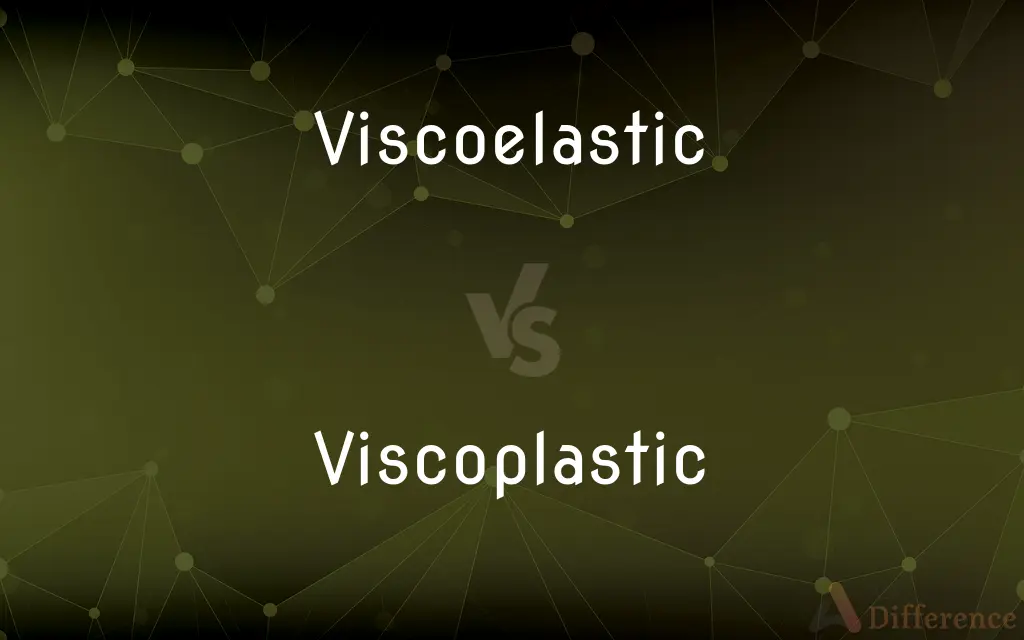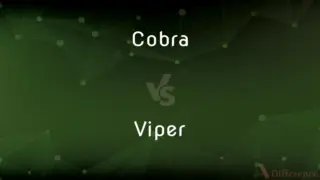Viscoelastic vs. Viscoplastic — What's the Difference?
By Tayyaba Rehman — Updated on September 28, 2023
Viscoelastic materials exhibit both viscous and elastic behaviors when undergoing deformation, while viscoplastic materials display permanent deformation after reaching a certain yield stress.

Difference Between Viscoelastic and Viscoplastic
Table of Contents
ADVERTISEMENT
Key Differences
Viscoelastic materials combine the characteristics of both viscous fluids and elastic solids. When a force is applied to a viscoelastic material, it will deform but will also return to its original shape once the force is removed. On the other hand, viscoplastic materials will undergo a permanent deformation when subjected to stress beyond a certain threshold. This permanent deformation is a defining characteristic of viscoplasticity.
In the realm of materials science, the distinction between viscoelastic and viscoplastic properties is crucial. Viscoelastic materials are prevalent in everyday life; examples include rubber bands and certain biological tissues. These materials can endure repeated stress and strain cycles. Viscoplastic materials, however, will deform and not completely return to their initial state after the applied stress is removed, displaying a combination of viscosity and plasticity.
Viscoelasticity is fundamentally time-dependent. It implies that the material's response will depend on the rate at which the force is applied. Viscoplasticity is also time-dependent but in a different way; the material will only begin to deform permanently after a specific stress level, known as yield stress, is achieved.
When designing products or structures, understanding whether a material is viscoelastic or viscoplastic is paramount. Viscoelastic materials can absorb energy and return it, which is useful in applications like shock absorption. Viscoplastic materials, conversely, are beneficial when permanent deformation is needed, such as in forming processes.
Comparison Chart
Behavior
Combines viscous and elastic properties.
Combines viscous properties with permanent deformation.
ADVERTISEMENT
Time Dependency
Response is time-dependent.
Begins permanent deformation after a specific stress level.
Recovery after Deformation
Returns to its original shape after removing stress.
Does not return to its original shape after stress is removed.
Example
Rubber bands.
Metals undergoing plastic deformation when being molded.
Use Cases
Useful in shock absorption applications.
Beneficial in forming processes where permanent shape is desired.
Compare with Definitions
Viscoelastic
A time-dependent response to stress, combining fluid-like flow and solid-like elasticity.
The viscoelastic nature of the gel made it perfect for cushioning impacts.
Viscoplastic
Unable to recover entirely to its original shape after stress is removed.
The viscoplastic material retained the imprint even after the pressure was gone.
Viscoelastic
Characterized by a combination of viscosity and elasticity.
The scientist studied the viscoelastic properties of the novel polymer.
Viscoplastic
Materials that undergo permanent deformation after reaching a yield stress.
The metal, being viscoplastic, took on a new shape after being pressed.
Viscoelastic
Materials that display both viscous and elastic characteristics during deformation.
The mattress pad's viscoelastic properties provided both support and comfort.
Viscoplastic
Combining viscous flow with irreversible plastic deformation.
The viscoplastic behavior of the clay made it ideal for sculpting.
Viscoelastic
Describing a material's resistance to flow and its ability to spring back.
The viscoelastic substance took a while to spread but eventually retained its form.
Viscoplastic
Characterized by flow behavior that results in permanent shape change.
Once the viscoplastic threshold was crossed, the material would never be the same again.
Viscoelastic
Able to recover its shape after a temporary deformation.
The viscoelastic foam returned to its original form after pressure was removed.
Viscoplastic
Displaying properties of viscosity and plasticity when subjected to external forces.
The viscoplastic nature of the compound was evident when it was molded.
Viscoelastic
Viscous and elastic.
Viscoplastic
Describing a material that behaves as a solid below a critical value of stress, but flows like a viscous liquid at greater values of stress.
Viscoelastic
Such a material
Viscoelastic
Having viscous as well as elastic properties
Common Curiosities
What does viscoelastic mean?
Viscoelastic refers to materials that display both viscous and elastic characteristics during deformation.
How do viscoelastic materials behave?
They can deform but will return to their original shape once the deforming force is removed.
How do viscoplastic materials behave?
They will deform permanently and not return to their initial state after stress is removed.
What's an example of a viscoelastic material?
Rubber bands are a common example of viscoelastic materials.
Where might I find viscoelastic materials in everyday life?
Memory foam mattresses and certain gels have viscoelastic properties.
What does viscoplastic mean?
Viscoplastic refers to materials that undergo permanent deformation after reaching a specific yield stress.
Are viscoelastic properties time-dependent?
Yes, the response of viscoelastic materials is time-dependent.
Are all plastics viscoplastic?
No, not all plastics are viscoplastic; some might exhibit viscoelastic properties.
Can you give an example of a viscoplastic material?
Metals undergoing molding processes often display viscoplastic behavior.
Is there a threshold stress for viscoplastic materials?
Yes, viscoplastic materials begin permanent deformation after a specific yield stress.
What's a primary use case for viscoplastic materials?
Forming processes, where a permanent shape change is desired.
Do viscoplastic materials have a time-dependent response?
Yes, but it's related to reaching a specific stress level before deforming permanently.
Is viscoelasticity exclusive to solids?
No, certain gels and other substances can also exhibit viscoelastic behaviors.
Can materials have both viscoelastic and viscoplastic properties?
Some materials might exhibit viscoelastic behavior under certain conditions and viscoplastic under others.
Are viscoelastic and viscoplastic terms used in specific fields?
They are primarily used in materials science, engineering, and physics to describe material behaviors.
Share Your Discovery

Previous Comparison
Woodcut vs. Engraving
Next Comparison
Cobra vs. ViperAuthor Spotlight
Written by
Tayyaba RehmanTayyaba Rehman is a distinguished writer, currently serving as a primary contributor to askdifference.com. As a researcher in semantics and etymology, Tayyaba's passion for the complexity of languages and their distinctions has found a perfect home on the platform. Tayyaba delves into the intricacies of language, distinguishing between commonly confused words and phrases, thereby providing clarity for readers worldwide.














































